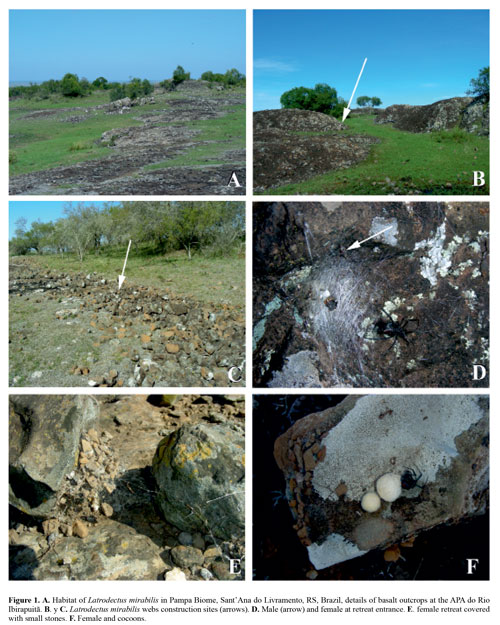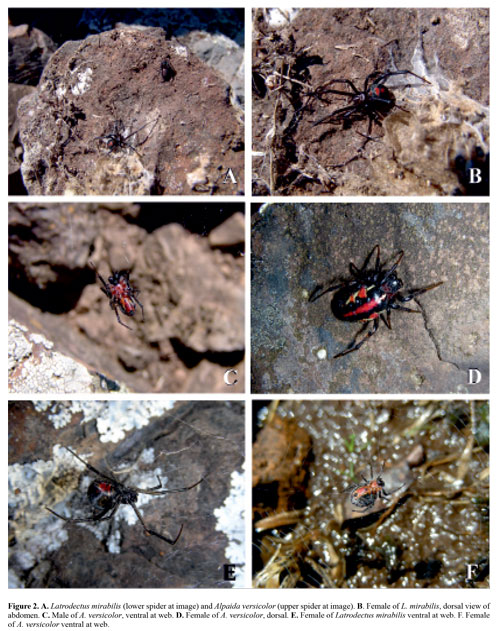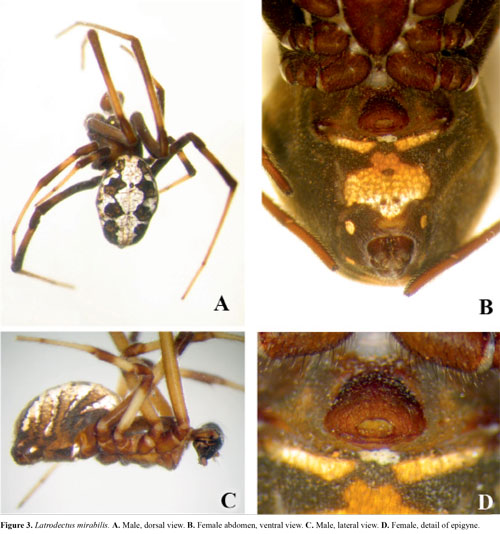Services on Demand
Journal
Article
Indicators
-
 Cited by SciELO
Cited by SciELO -
 Access statistics
Access statistics
Related links
-
 Cited by Google
Cited by Google -
 Similars in
SciELO
Similars in
SciELO -
 Similars in Google
Similars in Google
Share
Revista Colombiana de Entomología
Print version ISSN 0120-0488
Rev. Colomb. Entomol. vol.40 no.2 Bogotá July/Dec. 2014
NOTA CIENTÍFICA /SCIENTIFIC NOTE
First record of Latrodectus mirabilis (Araneae: Theridiidae) from southern Brazil and data on natural history of the species
Primer registro de Latrodectus mirabilis (Araneae: Theridiidae) en el sur de Brasil e información sobre la historia natural de la especie
Ricardo OttI,III, Everton Nei Lopes RodriguesII,IV and Maria Aparecida De Leão MarquesI,V
I Museu de Ciências Naturais, Fundação Zoobotânica do Rio Grande do Sul, Rua Dr. Salvador França, 1427, 90690-000, Porto Alegre, RS, Brazil. rott@fzb.rs.gov.br Corresponding author.
II Programa de Pós-Graduação em Biologia, Universidade do Vale do Rio dos Sinos, Av. Unisinos, 950,93022-000, São Leopoldo, RS, Brazil.enlrodrigues@yahoo.com.br
III Ph. D. 4 Professor, Ph. D. 5 Biologist.
Abstract
The spider Latrodectus mirabilis is recorded for Brazil, based on specimens collected in outcrops areas at Área de Proteção Ambiental do Rio Ibirapuitã, Sant’Ana do Livramento, in the state of Rio Grande do Sul. The only species of the genus known from Brazil were L. curacaviensis, L. geometricus and L. mactans.
Key words: New records. Latrodectinae. Neotropical. Pampa Biome.
Resumen
La araña Latrodectus mirabilis se registró a partir de Brasil, a partir de muestras recogidas en las zonas de afloramientos rocosos en el Área de Proteção Ambiental do Río Ibirapuitã, Sant’Ana do Livramento, Rio Grande do Sul, Brasil. Las únicas especies conocidas para el Brasil eran L. curacaviensis, L. geometricus and L. mactans.
Palabras clave: Nuevos registros. Latrodectinae. Neotropical. Bioma Pampa.
Introduction
Latrodectus Walckenaer, 1805 include spiders of relevant medical interest (Aguilera et al. 2009). The genus comprises 31 species (Platnick 2013). Some species show worldwide distribution as the brown widow Latrodectus geometricus C. L. Koch, 1841 and the popularly known and highly venomous black widow L. mactans (Fabricius, 1775). Garb et al. (2004) indicated that the very broad diet of this spiders includes a large range of invertebrates and also some warm and vertebrates, might explain the highly potent latrotoxinα, a vertebrates-specific neurotoxin, in the venom of these spiders. These characteristics combined with the synanthropic habits of some species make these spiders species of public health interest.
According to Levi (1959) there are at last three species of the genus Latrodectus recorded from Brazil: L. curacaviensis (Müller, 1776), L. geometricus and L. mactans. Of these, L.geometricus is a cosmopolitan species with possible African origin, while L. mactans and L. curacaviensis are much likely New World natives (Garb et al. 2004). Records of L. geometricus and L. curacaviensis from Brazil are well known and confirmed, however most records of L. mactans are dubious and are usually referred to as “Latrodectus group mactans” (Lira-da-Silva et al. 1995; Rocha Dias and Brazil 1999).
The introduced and synanthropic species L. geometricusis commonly found in southern Brazil with several records from different localities of Rio Grande do Sul registered in the arachnological collection of the Museu de Ciências Naturais, Fundação Zoobotânica do Rio Grande do Sul. On the other hand L. curacaviensis is commonly found further north along the Atlantic Forest area from southeast to northeast of Brazil, with no confirmed records in Rio Grande do Sul (Fundação Nacional de Saúde 1998). Latrodectus mirabilis (Holmberg, 1876) was originally described from Argentina (see distribution at Abalos 1980: 35) and is also known from Uruguay (Capocasale and Pereira 2003), Peru and “Patagônia” (Chile and Argentina), in the last case by a not clear taxonomic data register (Canals et al. 2004). As noted above L. mactans registers in Brazil are not entirely trustable; however the species was recorded to northeast of the country by Levi (1959).
According to Garb et al. (2004), based on molecular data, explained that the taxonomic status of L. mirabilis, L. variegatus Nicolet, 1849, L. corallinus Abalos, 1980 and L. diaguita Carcavallo, 1960 seems to be unclear because they “share nearly identical sequences” suggesting that the recognition of multiple species within groups could be nothing else as a “taxonomic artifact”. However, the herein presented identification of L. mirabilis was made based on the taxonomic characters proposed by Abalos (1980).
In this study, we present the records of Latrodectus mirabilis in Brazil in the state of Rio Grande do Sul, expanding its known geographic distribution in South America and also presenting data on natural history of species.
Material and methods
The material examined was deposited in the arachnological collection of Museu de Ciências Naturais da Fundação Zoobotânica do Rio Grande do Sul (MCN, curator: R. Ott). Images were obtained at stereomicroscope with a digital camera attached. Multi-focus stack images were made using Helicon Focus multi-range program. Records were obtained in two main locations Passo do Ferrão (30°27’15.97”S 55°43’25.71”W) and Passo do Cerrito (30°36’33.87”S 55°38’30.18”W) inside the Área de Proteção Ambiental do Rio Ibirapuitã (APA do Ibirapuitã), municipality of Sant’Ana do Livramento, Rio Grande do Sul, Brazil.
Results and discussion
Latrodectus mirabilis (Holmberg, 1876)
Figs. 1D, 2A-2B, 2E, 3A-3D
Theridium mirabile Holmberg, 1876: 11; L. curacaviensis,Levi, 1959: 39, fig. 69. L. mirabilis, Abalos, 1980: 31, figs. 1-13, 21.
Diagnosis. Latrodectus mirabilis is included in the L. mactans group by the shape of the male embolus, presenting three coils (Levi 1959; Bücherl 1965; Abalos 1980). The species can be distinguished from L. mactans by the smaller size of males (Abalos 1980: 33-34, figs. 11-14). The species is close L. quartus Abalos, 1980 and L. thoracicus Nicolet, 1849 by the shape of the female epigyne opening with usually straight rather than indented or irregular anterior border (Fig. 16; see also Abalos 1980: 33, 42, figs. 13, 38 and Aguilera 2009: 166, fig. 3a), by the smaller male size and by the paler male abdomen (Abalos 1980: 33, 42, figs. 11, 43; Aguilera et al. 2009: fig. 4f). Males of L. mirabilis can be distinguished from those of L. corallinus and L. diaguita by the shape of the dorsal markings on the abdomen (Fig. 13; see also Abalos 1980: 33, fig. 11). Females of L. mirabilis can be distinguished from those of L. quartus and L. thoracicus by the more rounded ectal borders of the female epigyne opening (Fig. 16; see also Abalos 1980: 33, 42, figs. 13, 38 and Aguilera 2009: 166, fig. 3a) and also from L. quartus by the shape of the ventral markings on the abdomen and L. corallinus by dorsal and ventral markings on the abdomen (Fig. 14; see also Abalos 1980: 33, 42, figs. 7-8, 41). Females of L. mirabilis can be distinguished from those of L. diaguita by the shape of the female epigyne opening (Fig. 16; see also Abalos 1980: 33, fig. 13).
Description: see Abalos (1980: 31-36; figs. 1-13).
Examined material. BRAZIL. Rio Grande do Sul. Sant’Ana do Livramento: 3♂, 10♀, Passo do Ferrão (30°27’15.97”S 55°43’25.71”W), R. Ott leg. (MCN49306); 1♀, 10.II.2012 (MCN49307); 1♀, 15.V.2012 (MCN49308); 1♀, 15.V.2012 (MCN49309), all Passo do Cerrito (APPC, 30°36’33.87”S 55°38’30.18”W), Equipe PELD leg.
Natural history. Latrodectus mirabilis (Figs. 1D, 2A-2B, 2E, 3A-3D) can be easily found at basalt outcrops or under stones in outcrops areas (Figs. 1A, AB) at the APA do Rio Ibirapuitã, located at the Pampa biome, similar to the environments reported for the species by Barrantes and Eberhardt (2010) and also reported for an undetermined species of Latrodectus by González (1977). No additional specimens were found elsewhere in the areas and so far none was registered in any anthropic areas in this region.
The web of this species is basically a plan sheet build with irregularly displaced treads; the bidimensional horizontal shape is also of irregular borders and can reach almost 60 cm in maximum diameter and is located 5-10 cm above ground in habitats such as nearly obliquous outcrops sides (Fig. 1B) to horizontal outcrops areas with or without loose stones (Fig. 1C). Spiders were never recorded at adjacent grasslands or shrub vegetation in this area. Grisolia et al. (1992) reported that the species could be frequently found in anthropic environments with many bite accident reports but no human death cases registered. At APA do Ibirapuitã, females were usually found inside a silk retreat (Fig. 1D) whichcan be structurally assembled with remains of prey (see also Abalos 1980), vegetation debris and more rarely with small stones (Fig. 1E). Adult males (Figs. 3A, 3C) were all collected in May (autumn at Southern Hemisphere), close to the female retreat (Fig. 1D).
It was observed the presence of webs of araneid Alpaida versicolor (Keyserling, 1877) very close to the webs of L. mirabilis, with spiders sharing even the same stone as retreat place (Fig. 2A). Interestingly in this case, the webs of A. versicolor were horizontally placed, in quite similar orientation positions as the nets of L. mirabilis (Figs. 2C, 2E, 2F). Some A. versicolor specimens is very similar as the coloration found at L. mirabilis of the same area (Figs. 2A-2F). It is questionable if A. versicolor specimens could take some advantage from the possible aposematic coloration of L. mirabilis; however similar observations were accomplished by Levi (1965) regarding L. mactans tredecimguttatus (Rossi, 1790) and two european arthropods species, the millipede Glomeris pulchra Koch, 1847 and the isopod Armadillidium klugii Brandt, 1833.
Acknowledgements
To CNPq for the grant of the EDITAL 59/2009 Programa de Pesquisas Ecológicas de Longa Duração (PELD) to MCN/ FZBRS. To ICM Bio for the support and to work authorizations at APA do Ibirapiuitã. To Eridiane Lopes da Silva and Raul Cândido da Trindade Paixão Coelho (ICM Bio) for the contacts with local farmers and for the field work support. To Sr. Rodolfo Cunha (Fazenda São Diogo) for the support of the field work through providing lodging facilities. To anonym reviewers for all ther the improvement of this manuscript.
Literature cited
ABALOS, J. W. 1980. Las arañas del género Latrodectus en la Argentina. Obra Centen. Mus. La Plata 6: 29-51. [ Links ]
AGUILERA, M. A.; D'ELÍA, G.; CASANUEVA, M. E. 2009. Revalidation of Latrodectus thoracicus Nicolet, 1849 (Araneae: Theridiidae): biological and phylogenetic antecedens. Gayana 73 (2): 161-171. [ Links ]
BARRANTES, G.; EBERHARD, W. G. 2010. Ontogeny repeats phylogeny in Steatoda and Latrodectus spiders. Journal of Arachnology 38: 485-494. [ Links ]
BÜCHERL, W. 1965. Latrodectus e latrodectismo na América do Sul. Memórias do Instituto Butantan 32: 95-100. [ Links ]
CANALS, M. L.; CASANUEVA, M. E.; AGUILERA, M. A. 2004. Cuáles son las especies de arañas peligrosas en Chile? Revista Médica de Chile 132: 773-776. [ Links ]
CAPOCASALE, R. M.; PEREIRA, A. 2003. Diversidad de la Biota Uruguaya. Anales Museo Nacional de Historia Natural y Antropologia, Serie 2, 10 (5): 1-32. [ Links ]
GARB, J. E.; GONZÁLEZ, A.; GILESPIE, R. G. 2004. The black widow spider genus Latrodectus (Araneae: Theridiidae): phylogeny, biogeography, and invasion history. Molecular Phylogenetics and Evolution 31: 1127-1142. [ Links ]
GONZÁLES, A. 1977. Observaciones bioecológicas sobre una especie del género Latrodectus (Walckaener, 1805), del grupo mactans de Sierra de la Ventana (provincia de Buenos Aires, Argentina) (Araneae, Theridiidae), I - habitat y ciclo vital. Physys 36 (92): 277-282. [ Links ]
GRISOLIA, C. S.; PELUSO, F. O.; STANCHI, N. O.; FRANCINI, F. 1992. Epidemiología del latrodectismo en la Provincia de Buenos Aires, Argentina. Revista de Saúde Pública, São Paulo 26 (1): 1-5. [ Links ]
HOLMBERG, E. L. 1876. Arácnidos argentinos. Anales de Agricultura de la República Argentina 4: 1-30. [ Links ]
FUNDAÇÃO NACIONAL DE SAÚDE. 1998. Manual de Diagnóstico e Tratamento de Acidentes por Animais Peçonhentos.Ministério da Saúde, Brasília, 131 p. [ Links ]
LEVI, H. W. 1959. The spider genus Latrodectus (Araneae, Theridiidae). Transactions of American Microscopical. Society 78: 7-43. [ Links ]
LEVI, H. W. 1965. An unusual case of mimicry. Evolution 19: 261-262. [ Links ]
LIRA-DA-SILVA, R. M. L.; MATOS, G. B.; SAMPAIO, R. O.; NUNES, T. B. 1995. Estudo restropectivo de latrodectismo na Bahia. Revista da Sociedade Brasileira de Medicina. Medicina Tropical 28 (3): 205-210. [ Links ]
PLATNICK, N. I. 2013. The world spider catalog, version 14.0. New York, American Museum of Natural History. Available at http://research.amnh.org/iz/spiders/catalog. [Review date: 24 November 2013] [ Links ].
ROCHA DIAS, M. F.; BRAZIL, T. K. 1999. Comportamento e padrão alimentar de uma espécie de Latrodectus do grupo mactans (Araneae, Theridiidae) em cativeiro. Revista Brasileira de Zoologia 16 (4): 991-996. [ Links ]
Received: 27-Dec-2013
Accepted: 3-Nov-2014
















